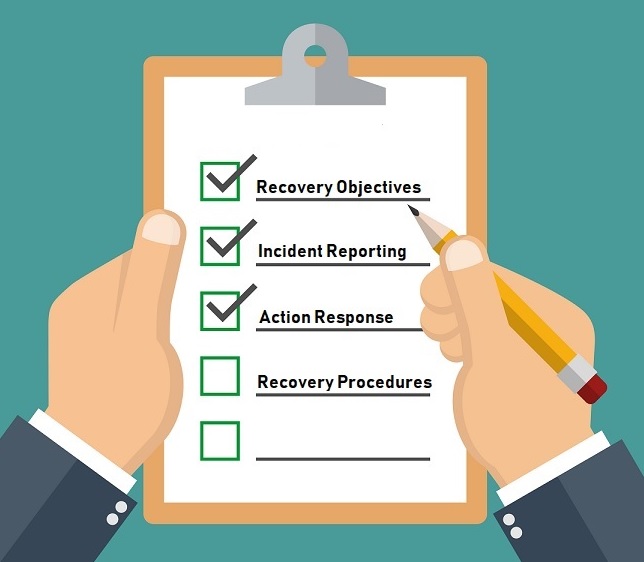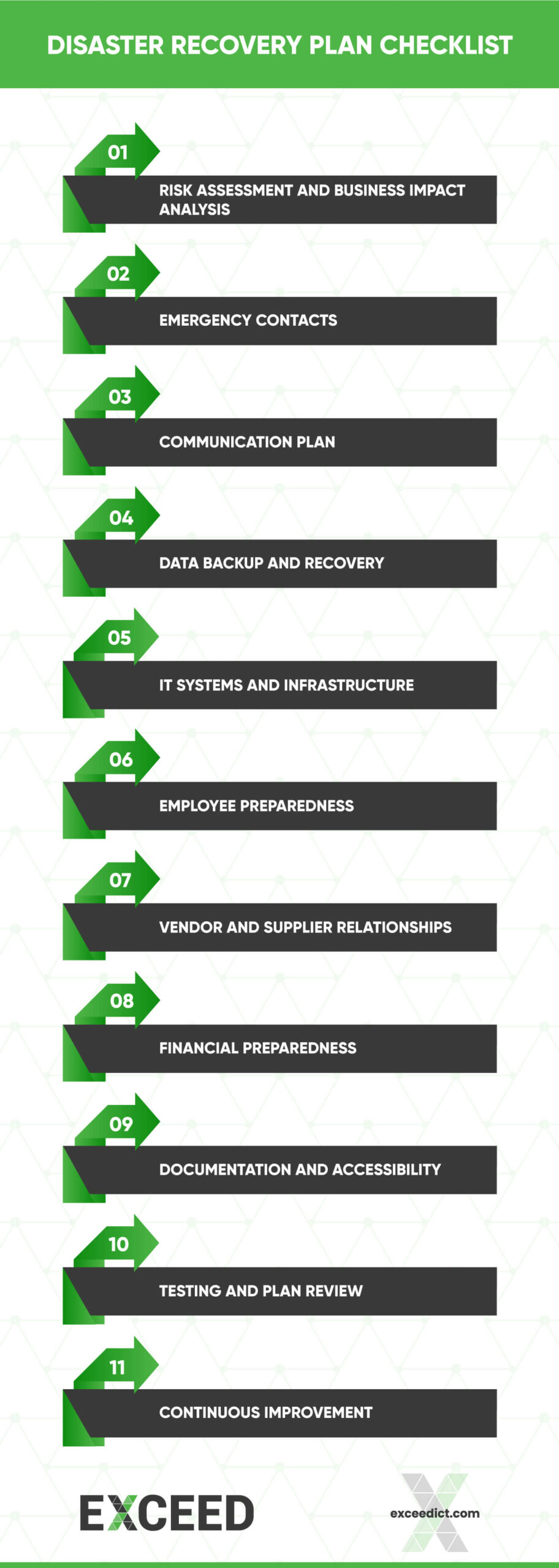
Disaster recovery plan checklist template tailored for a small business with a focus on network and IT aspects.
 A Disaster Recovery Plan checklist template is a comprehensive document that outlines the steps, procedures, and guidelines an organization should follow to ensure business continuity and data recovery in the event of a disaster or unexpected event.
A Disaster Recovery Plan checklist template is a comprehensive document that outlines the steps, procedures, and guidelines an organization should follow to ensure business continuity and data recovery in the event of a disaster or unexpected event.
It’s designed to help an organization recover its critical systems, data, and operations as quickly and efficiently as possible after a disruptive event.
Disaster Recovery Plan Checklist
Risk Assessment and Business Impact Analysis:
 Identify potential disasters and threats to your business (e.g., natural disasters, cyber incidents).
Identify potential disasters and threats to your business (e.g., natural disasters, cyber incidents).- Evaluate the potential impact of each disaster scenario on business operations.
- Prioritise critical business functions and assets.
Emergency Contacts:
- Compile a list of emergency contacts, including employees, stakeholders, suppliers, and emergency services.
- Ensure contact information is accurate and up-to-date.
Communication Plan:
- Establish a clear communication hierarchy and channels for internal and external communication during and after a disaster.
- Define roles and responsibilities for communication tasks.
Data Backup and Recovery:
- Regularly back up all critical data, applications, and configurations.
- Store backups securely off-site or in the cloud.
- Test data restoration procedures periodically.
IT Systems and Infrastructure:
- Document your IT systems, network topology, hardware, and software configurations.
- Implement redundancy and failover mechanisms where feasible.
- Develop procedures for quick system recovery and reconfiguration.
Employee Preparedness:
- Educate employees about disaster response and recovery protocols.
- Conduct training sessions and drills to ensure employees understand their roles and responsibilities.
- Provide guidance on personal preparedness.
Vendor and Supplier Relationships:
- Maintain contact details for key vendors and service providers.
- Understand their disaster recovery plans and capabilities.
Financial Preparedness:
- Allocate budget for disaster recovery resources and services.
- Consider business interruption insurance and data loss coverage.
Documentation and Accessibility:
- Keep a well-organised and up-to-date copy of the disaster recovery plan.
- Store physical and electronic copies in secure, easily accessible locations.
Testing and Plan Review:
- Conduct regular disaster recovery drills to assess the effectiveness of the plan.
- Revise the plan based on lessons learned and changing business needs.
Continuous Improvement:
- Establish a process for ongoing plan review and updates.
- Stay informed about emerging threats and technologies that could impact your disaster recovery strategy.
Remember, this checklist is a foundation for creating your disaster recovery plan. Adapt it to your specific business requirements, and ensure that key stakeholders are involved in the planning and testing process. Regularly reviewing and updating your plan will help keep your business resilient in the face of unexpected events.
Feel free to customise this template according to your small business’s specific needs and circumstances. Regularly reviewing and updating your disaster recovery plan is crucial to ensure its effectiveness in safeguarding your business against unforeseen events.
You may also like to know more about
- IT Disaster Recovery Planning Process for Ensuring Business Continuity.
- Disaster Recovery Plan For Ensuring Business Continuity in Challenging Times.
- Business Continuity Planning vs Disaster Recovery Planning.
- Step by Step Guide for a business continuity plan.
- What is Business Continuity Planning? Importance, Risk Assessment, & Core Objectives.
- Understanding the Disaster Recovery Planning – steps, benefits and best practices.
- Disaster Recovery Planning To Ensure The Connectivity in Crisis.
Stay connected with EXCEED ICT
Stay connected with EXCEED ICT by joining our social networks (given at footer). Get the latest updates, news, and tips for enterprise device deployment. Follow us on Twitter, Facebook, and LinkedIn for the best enterprise device deployment solutions.
Help us to improve our enterprise by rating us on Google Maps. Your feedback and comments are valuable to us and will be used to make our services even better.



 Identify potential disasters and threats to your business (e.g., natural disasters, cyber incidents).
Identify potential disasters and threats to your business (e.g., natural disasters, cyber incidents).